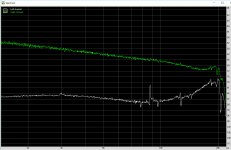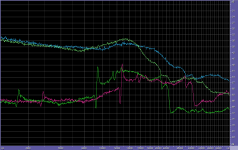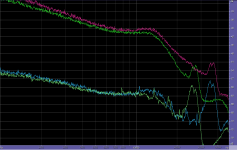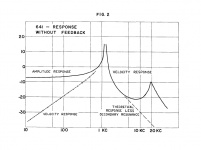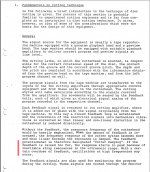Here from the same recording as used for the previous image, now the FFT over 16 sec instead of calculated over just 4 sec.
The peak at 8.8kHz is still there in its full strength.
the 3kHz peak seems almost gone, but the whole spectrum around 3Khz has been lifted, where the level at 3kHz is still the same.
So the effect of a scratch after all ?
Hans
The peak at 8.8kHz is still there in its full strength.
the 3kHz peak seems almost gone, but the whole spectrum around 3Khz has been lifted, where the level at 3kHz is still the same.
So the effect of a scratch after all ?
Hans
Attachments
Here from the same recording as used for the previous image, now the FFT over 16 sec instead of calculated over just 4 sec.
The peak at 8.8kHz is still there in its full strength.
the 3kHz peak seems almost gone, but the whole spectrum around 3Khz has been lifted, where the level at 3kHz is still the same.
So the effect of a scratch after all ?
Hans
A scratch is an impulse every 1.8 sec. I don't see it causing any of this. Try 45 RPM if it's from the cutter it should move, if the cart it will stay at 8k.
More likely a smps artifact sneaking in somewhere.
The suggestion to try 45rpm vs 33rpm to see if the artifact is from the record is an excellent suggestion
The suggestion to try 45rpm vs 33rpm to see if the artifact is from the record is an excellent suggestion
More likely a smps artifact sneaking in somewhere.
They didn't exist when some of these LP's were cut. They are not there playing a blank groove immediately after either. Another thing to eliminate is some kind of strange aliasing artifact.
Last edited:
I don't see many impulses every 1.8 sec, but several large spikes at random spots,A scratch is an impulse every 1.8 sec. I don't see it causing any of this. Try 45 RPM if it's from the cutter it should move, if the cart it will stay at 8k.
see the image below.
Hans
Attachments
Last edited:
I don't see many impulses every 1.8 sec, but
A scratch crosses more than one revolution, those are isolated pops they still can't cause a fixed spectral anomaly. I've unpacked everything I need to repeat some of these measurements on an isolated battery powered setup.
When I cut an area without spikes from the above .wav file, spectral noise is as in the original image.
When isolating the part with spikes, the complete area around 3kHz is lifted as in the second image.
So it seems that these spikes are effecting the noise level around 3 Khz.
Hans
When isolating the part with spikes, the complete area around 3kHz is lifted as in the second image.
So it seems that these spikes are effecting the noise level around 3 Khz.
Hans
When I cut an area without spikes from the above .wav file, spectral noise is as in the original image.
When isolating the part with spikes, the complete area around 3kHz is lifted as in the second image.
So it seems that these spikes are effecting the noise level around 3 Khz.
Yes the spike contains a broad range of frequencies. There are so few you could remove them, I think Audacity has a tool. I have a tool that works but only in Audition. Hans this is fairly basic spectral analysis stuff.
Next logical step is to work out what is in common between yours and Scott's measurement and analysis, perhaps?When you have concrete ideas, I'm there
LD
Next logical step is to work out what is in common between yours and Scott's measurement and analysis, perhaps?
LD
Just ran the 33.33/45 test and it's clear the problem is on the LP . What do many LP's have in common, well for one there are not many models of recording lathes out there. I'm using Audition which has overlapped FFT averaging built in, IFAIK it does the right thing to optimize the result. This is disturbing in the context of getting a DIY test LP produced that can really nail some very subtle issues.
BTW it's a log frequency plot so a constant lateral shift is what you get (the slight mains incursion did not move on the two plots).
Attachments
Last edited:
Just ran the 33.33/45 test and it's clear the problem is on the LP . What do many LP's have in common, well for one there are not many models of recording lathes out there. I'm using Audition which has overlapped FFT averaging built in, IFAIK it does the right thing to optimize the result. This is disturbing in the context of getting a DIY test LP produced that can really nail some very subtle issues.
BTW it's a log frequency plot so a constant lateral shift is what you get (the slight mains incursion did not move on the two plots).
That’s very convincing indeed.
I’m amazed how reproducible it is.
What are the details of your recording, Fs 96 kHz ?
Size of the FFT, length of the time frame ?
Fs 96 kHz ?
Size of the FFT, length of the time frame ?
24/96 64k FFT but as I said the software computes the overlap and add, for long time records it is sometimes 100's of FFT's.
Here is the Adjust +, much better but the stuff beyond 20k is still the recording. I'm surprised we never did this before, looks like it would be hard to look at HF cart issues with an LP as source.
Attachments
24/96 64k FFT but as I said the software computes the overlap and add, for long time records it is sometimes 100's of FFT's.
Here is the Adjust +, much better but the stuff beyond 20k is still the recording. I'm surprised we never did this before, looks like it would be hard to look at HF cart issues with an LP as source.
I’ll try to repeat this tomorrow with an MC Cart.
Scott: Looking at your adjust+ plots they look awfully close to the stuff LD posted on modelling the cantilever as a transmission line. Certainly indicative of something resonating.
Scott: Looking at your adjust+ plots they look awfully close to the stuff LD posted on modelling the cantilever as a transmission line. Certainly indicative of something resonating.
Except the frequencies move with the LP not the cart.
I found the original Fairchild AES paper on their feedback cutterhead AES E-Library >> A New Stereo Feedback Cutterhead System The discuss things like resonances and getting the target response. (Images attached are from the paper). Admittedly this is from 1958 and later cutterheads were hopefully better. Still they all follow the same model.
No question that the cutterhead would have a substantial impact on the composite performance. Also look at the separation figures for both cutterheads and cartridges. Depending on your perspective its amazing performance and its not much.
No wonder the best records were usually 1/2 speed mastered.
No question that the cutterhead would have a substantial impact on the composite performance. Also look at the separation figures for both cutterheads and cartridges. Depending on your perspective its amazing performance and its not much.
No wonder the best records were usually 1/2 speed mastered.
Attachments
These too
http://www.torbenteknik.dk/Ortofon ...ds - Leaflet - high resolution - 21111609.PDF
http://www.torbenteknik.dk/Ortofon ...Manual - Part 1 - Fundamentals - 21111632.PDF
http://www.torbenteknik.dk/Ortofon ...ords by Fritz Nygaard - Part 1 - 25111618.PDF
http://www.torbenteknik.dk/Ortofon ...ords by Fritz Nygaard - Part 2 - 25111619.PDF
George
http://www.torbenteknik.dk/Ortofon ...ds - Leaflet - high resolution - 21111609.PDF
http://www.torbenteknik.dk/Ortofon ...Manual - Part 1 - Fundamentals - 21111632.PDF
http://www.torbenteknik.dk/Ortofon ...ords by Fritz Nygaard - Part 1 - 25111618.PDF
http://www.torbenteknik.dk/Ortofon ...ords by Fritz Nygaard - Part 2 - 25111619.PDF
George
Attachments
I am glad that Scott has proved that the LP is flawed.
The cutter head is a candidate, but there are two other possibilities that I can think of:
1) The noise source. If the noise is digitally generated, as it often is, there may well be cyclic errors in the spectrum
2) The delay line. There are just too many glitches for a simple mechanical resonance. Some sort of feedback around a delay might cause the glitches seen
The cutter head is a candidate, but there are two other possibilities that I can think of:
1) The noise source. If the noise is digitally generated, as it often is, there may well be cyclic errors in the spectrum
2) The delay line. There are just too many glitches for a simple mechanical resonance. Some sort of feedback around a delay might cause the glitches seen
- Status
- Not open for further replies.
- Home
- Source & Line
- Analogue Source
- Cartridge dynamic behaviour
